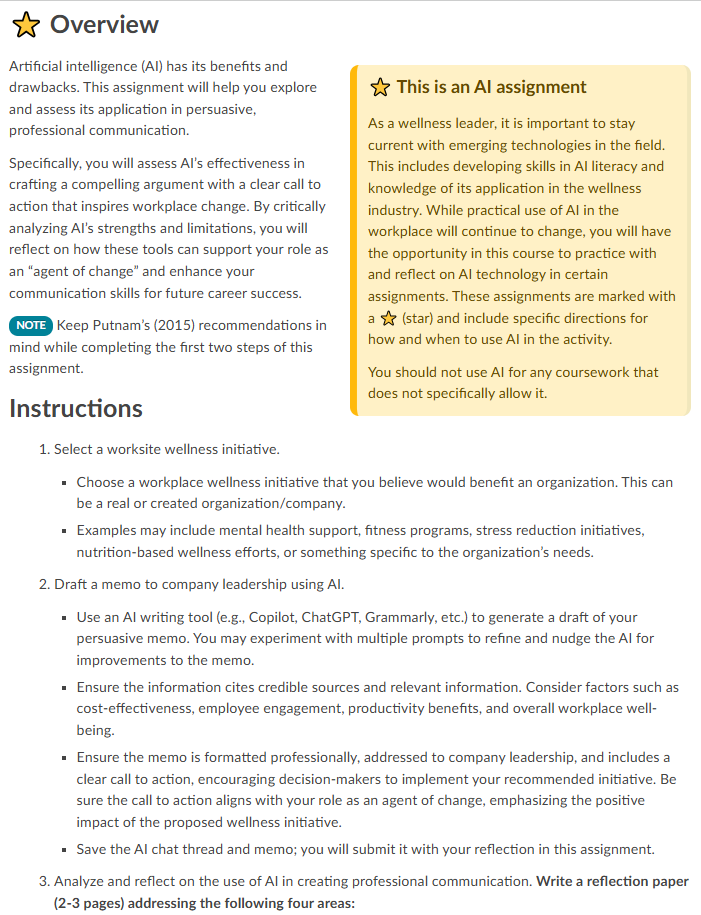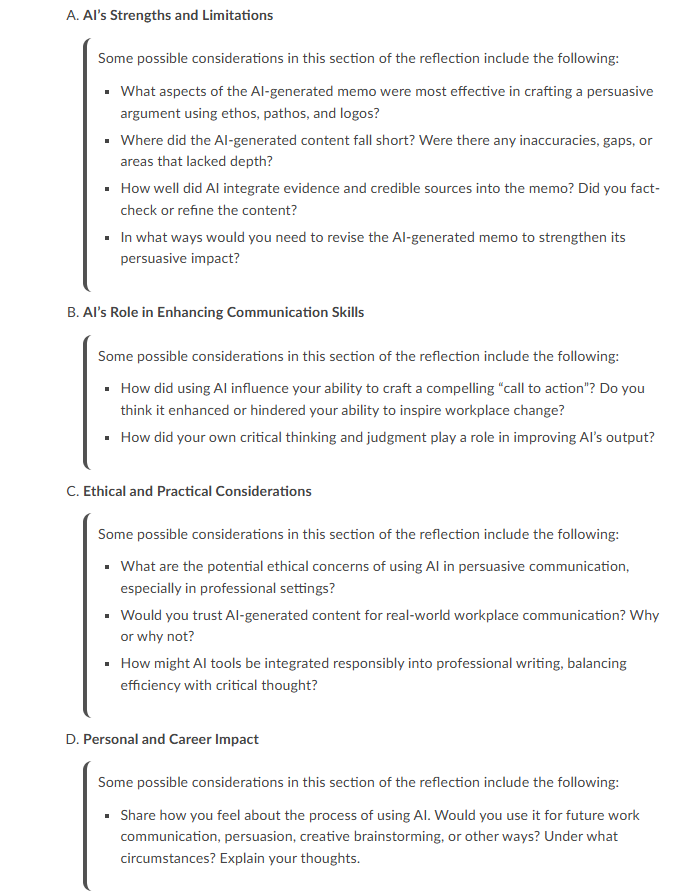Reflecting on Creating a Wellness Proposal with AI
Overview
Students use AI to craft a memo proposing a wellness initiative to company leadership and then reflect on the AI drafting process.
Why Use This?
This assignment gives students hands-on experience using AI while promoting critical thinking about how these tools can influence work practices, both positively and negatively. Students also strengthen their professional written communication skills as they craft a clear and persuasive memo. Completing this activity allows students to critically engage with AI tools, as well as use them as they would in a professional wellness role.
How Does It Work?
Students use AI to create a persuasive memo to company leadership, real or imagined, advocating for a wellness initiative they believe will benefit the organization. After drafting their memo, students write a 2-3 page reflection on their experience using AI, including its strengths and limitations, how it enhanced their communication skills, ethical and practical considerations, and potential impacts on their personal and professional development.

Overview
Artificial intelligence (AI) has its benefits and drawbacks. This assignment will help you explore and assess its application in persuasive, professional communication.
Specifically, you will assess AI’s effectiveness in crafting a compelling argument with a clear call to action that inspires workplace change. By critically analyzing AI’s strengths and limitations, you will reflect on how these tools can support your role as an “agent of change” and enhance your communication skills for future career success.
NOTE Keep Putnam’s (2015) recommendations in mind while completing the first two steps of this assignment.
This is an AI assignment
As a wellness leader, it is important to stay current with emerging technologies in the field. This includes developing skills in AI literacy and knowledge of its application in the wellness industry. While practical use of AI in the workplace will continue to change, you will have the opportunity in this course to practice with and reflect on AI technology in certain assignments. These assignments are marked with a ⭐ (star) and include specific directions for how and when to use AI in the activity.
You should not use AI for any coursework that does not specifically allow it.
Instructions
Select a worksite wellness initiative.
Choose a workplace wellness initiative that you believe would benefit an organization. This can be a real or created organization/company.
Examples may include mental health support, fitness programs, stress reduction initiatives, nutrition-based wellness efforts, or something specific to the organization’s needs.
Draft a memo to company leadership using AI.
Use an AI writing tool (e.g., Copilot, ChatGPT, Grammarly, etc.) to generate a draft of your persuasive memo. You may experiment with multiple prompts to refine and nudge the AI for improvements to the memo.
Ensure the information cites credible sources and relevant information. Consider factors such as cost-effectiveness, employee engagement, productivity benefits, and overall workplace well-being.
Ensure the memo is formatted professionally, addressed to company leadership, and includes a clear call to action, encouraging decision-makers to implement your recommended initiative. Be sure the call to action aligns with your role as an agent of change, emphasizing the positive impact of the proposed wellness initiative.
Save the AI chat thread and memo; you will submit it with your reflection in this assignment.
Analyze and reflect on the use of AI in creating professional communication. Write a reflection paper (2-3 pages) addressing the following four areas:

A. AI’s Strengths and Limitations
Some possible considerations in this section of the reflection include the following:
What aspects of the AI-generated memo were most effective in crafting a persuasive argument using ethos, pathos, and logos?
Where did the AI-generated content fall short? Were there any inaccuracies, gaps, or areas that lacked depth?
How well did AI integrate evidence and credible sources into the memo? Did you fact-check or refine the content?
In what ways would you need to revise the AI-generated memo to strengthen its persuasive impact?
B. AI’s Role in Enhancing Communication Skills
Some possible considerations in this section of the reflection include the following:
How did using AI influence your ability to craft a compelling “call to action”? Do you think it enhanced or hindered your ability to inspire workplace change?
How did your own critical thinking and judgment play a role in improving AI’s output?
C. Ethical and Practical Considerations
Some possible considerations in this section of the reflection include the following:
What are the potential ethical concerns of using AI in persuasive communication, especially in professional settings?
Would you trust AI-generated content for real-world workplace communication? Why or why not?
How might AI tools be integrated responsibly into professional writing, balancing efficiency with critical thought?
D. Personal and Career Impact
Some possible considerations in this section of the reflection include the following:
Share how you feel about the process of using AI. Would you use it for future work communication, persuasion, creative brainstorming, or other ways? Under what circumstances? Explain your thoughts.
Keep In Mind
- Some students may be uncomfortable using AI. Include a rationale explaining why learning this skill and interacting with AI critically is important.
- Encourage students to verify AI-generated content for accuracy before including it in professional documents; for example, this assignment requires students to include outside sources in their memo.
- Consider providing examples of professional memos or templates to help students structure their work effectively.